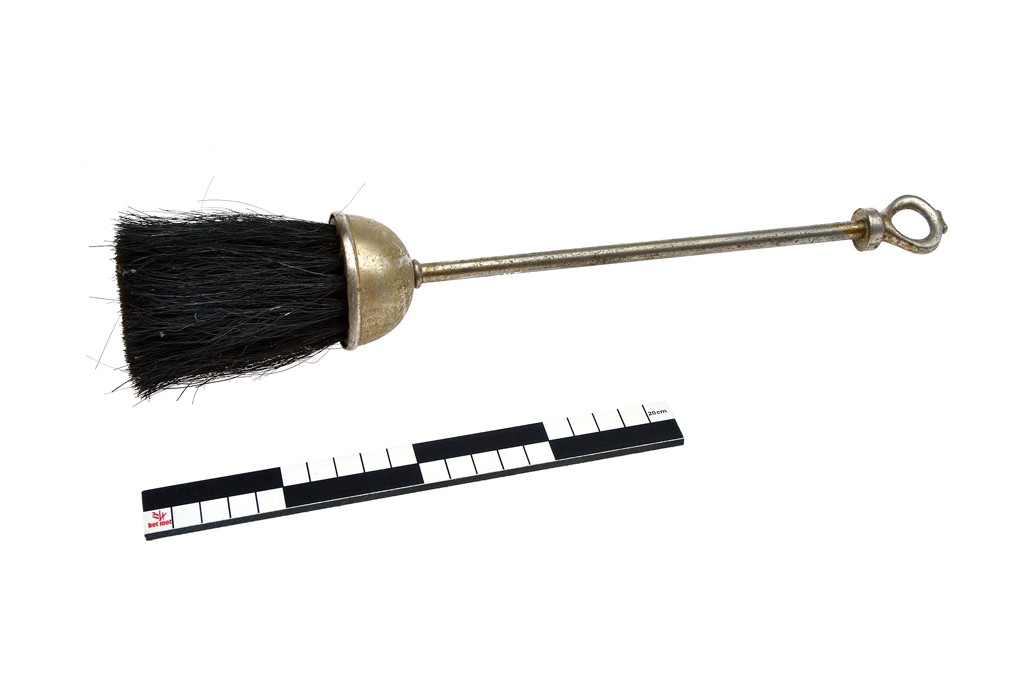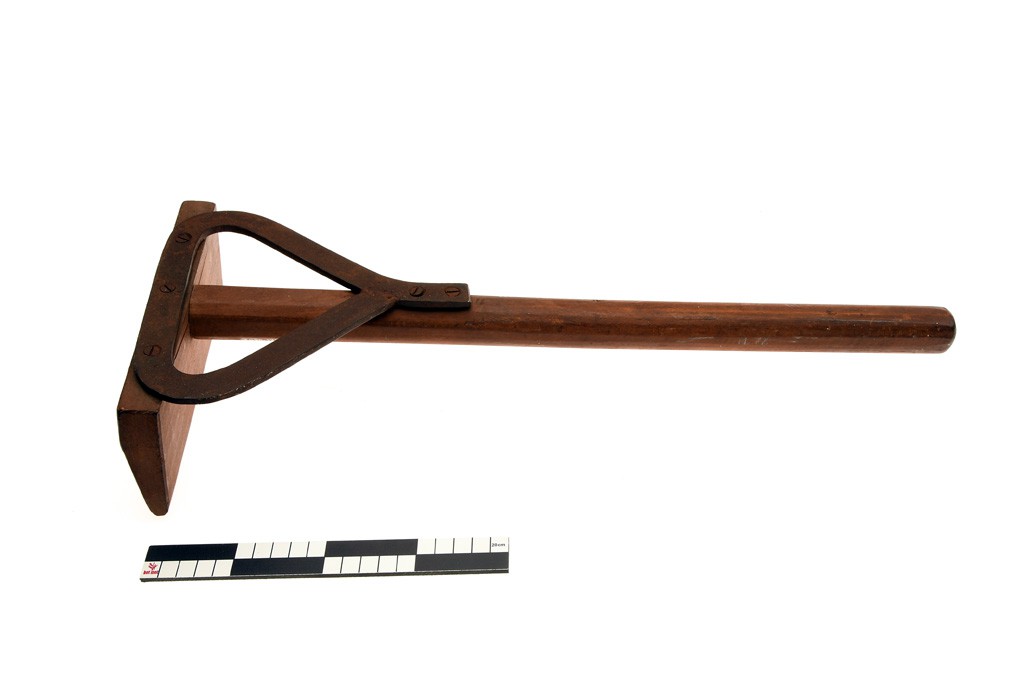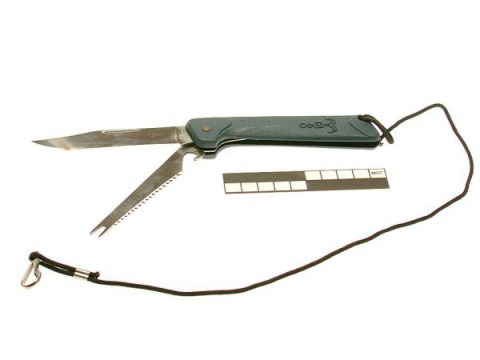ID-DOC: general search
Here you can enter a general keyword and perform a general search.
??? What are these question marks doing here? These represent tools which we know by a Dutch or French name, but who's English name is yet unknown. Suggestions are always welcome!
If you cannot find a certain tool, or if you experience other problems with this page, please let us know at info@mot.be.
Search for: tool
Showing search results 501 - 550
1,422 results found

Elastration pliers
Forceps for tying the tails and testicles of lambs. The jaws of these
pliers consist of four pins. With this, the rancher can open an elastic and
place it around the tail or around the scrotum of the lamb to tie it off.
The part after the elastic eventually dies due to lack of blood
circulation. [MOT]

Ellipsograph
This text can only be consulted in Dutch
<https://www.mot.be/resource/Tool/ellipsograph?lang=nl>

Emasculator (for piglet)
Piglets are usually neutered in their first three weeks of life. This is
done in the following way: After an incision has been made in the scrotum
with a scalpel - so that the testes are free to hang - the spermatic cord
is twisted until it breaks. In young piglets this is done with the help of
a few clamping pliers or even by hand. On piglets of several months old,
the spermatic cord is already relatively large and castration is done with
an emasculator (1). One jaw is rectangular (approx. 5 cm by 1 cm) with an
elongated cutout that has grooves on one side and a sharp cut on the other,
the other jaw has a concave cut. The jaws can be screwed on using a
clamping screw. After the incision, the spermatic cord is caught with the
jaws, which are squeezed tightly and tightened with the clamping screw; The
forceps are turned a few times until the spermatic cord breaks and then
they are squeezed completely closed so that the testicle is cut off. See
also castration tongs. [MOT] (1) See BERTHELON.

Embossing hammer
This text can only be consulted in Dutch
<https://www.mot.be/resource/Tool/embossing-hammer?lang=nl>

Embossing pliers
This text can only be consulted in Dutch
<https://www.mot.be/resource/Tool/288?lang=nl>

Embossing tool
This text can only be consulted in Dutch
<https://www.mot.be/resource/Tool/embossing-tool?lang=nl>

Embroiderie scissors
This text can only be consulted in Dutch
<https://www.mot.be/resource/Tool/embroiderie-scissors?lang=nl>

Endive harvesting fork
This text can only be consulted in Dutch
<https://www.mot.be/resource/Tool/endive-harvesting-fork?lang=nl>

Endive lifting fork
The endive or chicory (Chicorium intybus L. var. Foliosum) can be harvested
with the help of a spade, a fork or a plow (1), but also with a special
tool, the endive fork. It has two short (approx. 25 cm) tines that are
bent apart in the middle - the distance between the tines is approx. 2 cm -
and which are attached to a short, wooden T (2) or D handle ( approx. 30
cm). The endive lifting fork is put into the ground behind the plant. By
pushing the stem of the fork backwards, the root of the plant can easily be
pulled out of the ground. See also the beet lifting fork, endive harvesting
fork. [MOT] (1) SIMON: 13. (2) Sometimes the stem does not protrude in the
middle of the handle (see MOT V 2012.0554).

Enema syringe
Metal (tin or copper) or rubber syringe (1) with which an enema is applied
through the vent opening in the rectum, for example to promote bowel
movements or to administer medicines or food (2); for humans an irrigator
is also used, sometimes an enema. The enema sprayer for livestock, where
one applies 3 to 4 liters (3), is about 60-70 cm long. This one for people,
about 20 cm. See also the syringer for flowers. [MOT] (1) Exceptionally
also glass (BENNION: 170). (2) Tobacco smoke was sometimes used to
reanimate drowning people. (3) Larousse agricole s.v. lavement.

Engineer's ratchet brace
This text can only be consulted in Dutch
<https://www.mot.be/resource/Tool/engineers-ratchet-brace?lang=nl>

Erasing knife
There are different models of erasing knives. They are used mostly in the
office to scrape pencil lines or ink stains from the paper. See also
penknife. For more technical information see the dutch version of this
page. [MOT]

Escargot tongs
Escargot are often too hot to hold with the hand, so escargot tongs are
used. These tongs have crossed arms that are held closed by a spring. The
spring is adapted to the shape of the cochlea, so that the escargot can be
grasped well. Due to the spring, the tongs clamp around the escargot when
the arms are no longer squeezed. The cochlea is now fixed enough to remove
the meat with an escargot fork.See also the snail plate. [MOT]

Exagonal key
This text can only be consulted in Dutch
<https://www.mot.be/resource/Tool/exagonal-key?lang=nl>

Excluder cleaning tool
This text can only be consulted in Dutch
<https://www.mot.be/resource/Tool/excluder-cleaning-tool?lang=nl>

Extracting forceps
The dentist has a set - a minimum of ten - of forceps to extract the teeth.
The direction of the mouth, its opening width and the shape of the jaws are
each adapted to specific teeth. There are pliers for the upper and for the
lower teeth, for the left and for the right teeth, for the incisors and
canines, for the molars and for the wisdom teeth. [MOT]

Eyelash curler
This text can only be consulted in Dutch
<https://www.mot.be/resource/Tool/eyelash-curler?lang=nl>

Eyelet extractor
This text can only be consulted in Dutch
<https://www.mot.be/resource/Tool/eyelet-extractor?lang=nl>

Eyelet pliers
This text can only be consulted in Dutch
<https://www.mot.be/resource/Tool/257?lang=nl>

Faggot press
This text can only be consulted in Dutch
<https://www.mot.be/resource/Tool/faggot-press?lang=nl>

Fagot fork
This text can only be consulted in Dutch
<https://www.mot.be/resource/Tool/1095?lang=nl>

Feather duster
This text can only be consulted in Dutch
<https://www.mot.be/resource/Tool/feather-duster?lang=nl>

Fencing pliers
This text can only be consulted in Dutch
<https://www.mot.be/resource/Tool/fencing-pliers?lang=nl>

File brush
Steel brush made of short (approx. 1 cm) kinked metal wires that protrude
through a thick (approx. 0.4 cm) piece of fabric. The latter is glued to a
thin board (length approx. 10-15.5 cm; width approx. 2.5-5.5 cm) with a
handle or a wooden block. A file brush is used to remove wood or metal
filings from the file. Brushing is done in the direction of the file cut.
[MOT

File cutter's hammer
Description under construction... For more information about this tool, see
the dutch version of this file.

Fillet
This text can only be consulted in Dutch
<https://www.mot.be/resource/Tool/fillet?lang=nl>

Fillister plane
This text can only be consulted in Dutch
<https://www.mot.be/resource/Tool/fillister-plane?lang=nl>

Fire shovel (blacksmith)
The fire shovel is an iron shovel (length approx. 75 cm; width approx. 12
cm) with usually a flat blade and iron handle, with which the blacksmith
brings the coals together and covers the piece to be heated. Often the
handle is open. See also the ash shovel and fire shovel (stoker). [MOT]

Fire shovel (stoker)
Iron shovel (length 100-120 cm; width 15-20 cm) with flat blade and iron
handle, with which the coals are brought together in the boiler. Often the
stem ends in a ring. The stoker's fire shovel is usually part of a set,
along with a poker, oven rake and clinker tongs. See also fire shovel
(blacksmith). [MOT]

Fire swatter
The fire swatter is a hand tool that the fire brigade uses to extinguish a
running fire in grass, heather, etc. while beating. It replaces the common
twigs that were used in the past. The fire swatter consists of 10 flexible
iron bands that are clamped in a fan-like holder in which a long wooden
handle (approx. 200 cm) protrudes. To be distinguished from the eelspear.
See also the mop. [MOT]

Fire-hook
This text can only be consulted in Dutch
<https://www.mot.be/resource/Tool/fire-hook?lang=nl>

Fireman's Axe
The fireman's axe mainly serves to break a door or window, but it is used
for all kinds of purposes (1). Today it closely resembles a woodman's axe.
The straight handle often ends in a small sphere to provide a better grip.
Often there is a notch at the bottom of the blade to pull out nails and a
spring strengthens the connection with the stem (2). Very common is a
pointed axe, i.e. an axe with a heavy point opposite the edge (3). Here too
one or two springs are often found. Today there are firefighter's axes made
of a non-sparking alloy. The stem can be short (about 35 cm) or long (about
80-90 cm). The short handle often has slight bumps along its entire length
to provide a better grip; when isolated, it is usually serrated. The handle
of some models ends in a heavy iron point. [MOT] (1) Eg. to drive a peg of
emergency into the wall. Certain models appear in military and security
equipment. See also the window-smasher to shatter safety glass in a bus,
train or plane. (2) In most countries...

Fireplace brush
This text can only be consulted in Dutch
<https://www.mot.be/resource/Tool/fireplace-brush?lang=nl>

Firewood saw
Span saw for cutting firewood. Her arms are not parallel: the blade is
longer than the rope. One of the arms protrudes from under the blade and
serves as a handle. One arm of some saws has a handle cut out (1). Today,
the ordinary span saw is replaced by a metal arc saw, which is also used
for felling small trees. The firewood to be cut is usually placed on a
sawhorse. The saw works in both directions and is held horizontal or at an
angle. [MOT] (1) Eg. GOZIN: fig. 34.

Firmer chisel
Wide chisel (up to 8 cm) with one or two bevels, a tang and a neck, or a
socket and a shank, or all metal (1). Unlike the mortise chisel, the firmer
chisel is for heavy-duty work: carving out a pin, hollowing out a drill bit
hole, etc. The handle is usually fitted with one or two ferrules to prevent
cracking. Some chisels with a triangular cross-section, which often get
thicker towards the handle (2), are only slightly wider than thick. The
Japanese chisel (Japanese: õire nomi), also for the heavier work, is used
in a set with different widths and lengths. See also the joiner's gouge.
[MOT] (1) See a long specimen (95 cm) in "Les moulins": 24. (2) Eg. GROTH:
196.

First bit
This text can only be consulted in Dutch
<https://www.mot.be/resource/Tool/first-bit?lang=nl>

Fish chopping-knife
Chopper with a heavy, elongated or curved blade that is fixed in a straight
handle and used to chop fish into pieces. It is distinguishable from the
single-handed meat cleaver because it is lighter and has a rounded, thinner
blade. The cut is straight or convex. [MOT]

Fish fillet knife
This text can only be consulted in Dutch
<https://www.mot.be/resource/Tool/fish-fillet-knife?lang=nl>

Fish scaler
To quickly and easily scale fish, one usually uses a fish scaler, with
which one rubs the fish from tail to head, so against the scales. The
metal, always serrated, blade of the fish scaler can be in the shape of a
ring or triangle, a hair brush (1) or a dough scraper (2). The (wooden)
handle forms an obtuse angle (approx. 5 °) with the working part or is
attached to it with a kink. Often the fish scaler is part of the folding
fishing knife. The sharp, serrated edge of a shell can also serve as a fish
scaler. See also pocket knife. [MOT] (1) Eg. CAMPBELL FRANKLIN: 100 and
CAMPBELL: 84.

Fish spear
This text can only be consulted in Dutch. See also the eelspear.

Fish triage stick
This text can only be consulted in Dutch
<https://www.mot.be/resource/Tool/fish-triage-stick?lang=nl>

Fishing knife (folding)
This text can only be consulted in Dutch
<https://www.mot.be/resource/Tool/fishing-knife-folding?lang=nl>

Fishing rake
This text can only be consulted in Dutch
<https://www.mot.be/resource/Tool/fishing-rake?lang=nl>

Fishing spade
This text can only be consulted in Dutch
<https://www.mot.be/resource/Tool/fishing-spade?lang=nl>

Fitter's pliers
This text can only be consulted in Dutch
<https://www.mot.be/resource/Tool/fitters-pliers?lang=nl>

Flagging iron
This text can only be consulted in Dutch
<https://www.mot.be/resource/Tool/flagging-iron?lang=nl>

Flail
This text can only be consulted in Dutch
<https://www.mot.be/resource/Tool/flail?lang=nl>

Flare spanner
This text can only be consulted in Dutch
<https://www.mot.be/resource/Tool/flare-spanner?lang=nl>

Flask tongs
This text can only be consulted in Dutch
<https://www.mot.be/resource/Tool/213?lang=nl>

Flat chisel
